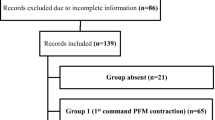Abstract
Introduction and hypothesis
The objectives of this study were to investigate the level of pelvic floor muscle (PFM) function in women with pelvic floor dysfunction (PFD) referred by gynaecologists and urologists for in-hospital pelvic floor muscle training (PFMT), and to identity associated factors for a low level of PFM function.
Methods
Data of women with PFD referred to a PFMT programme were included in a retrospective chart review. Measurement of PFM function performed by digital vaginal palpation included: voluntary PFM contraction, PFM strength (Modified Oxford Grading Scale) and PFM static endurance.
Results
Data of 998 women, mean age 56 (SD 13) years, with PFD (urinary incontinence, n = 757, anal incontinence, n = 36, pelvic organ prolapse, n = 111, other PFD, n = 94) were analysed. In all, 690 women (70 %) were, at baseline, unable to perform correct voluntary PFM contraction, mean PFM strength was 1.5 (SD 1.0) points, mean PFM static endurance was 16.7 (SD 16.1) seconds. Age ≥ 65 years and year of referral > 2000 were significantly (p < 0.01) associated with the ability to perform correct PFM contraction. Likewise, year of referral was significantly associated with high PFM strength (p < 0.01).
Conclusions
The majority of the women were unable to perform correct voluntary PFM contraction and almost all had low PFM strength. The most important factor associated with a low level of PFM function was age.


Similar content being viewed by others
References
Messelink B, Benson T, Berghmans B, Bo K, Corcos J, Fowler C et al (2005) Standardization of terminology of pelvic floor muscle function and dysfunction: report from the pelvic floor clinical assessment group of the International Continence Society. Neurourol Urodyn 24(4):374–380
Slieker-ten Hove MC, Pool-Goudzwaard AL, Eijkemans MJ, Steegers-Theunissen RP, Burger CW, Vierhout ME (2009) Face validity and reliability of the first digital assessment scheme of pelvic floor muscle function conform the new standardized terminology of the International Continence Society. Neurourol Urodyn 28(4):295–300
Haylen BT, de Ridder D, Freeman RM, Swift SE, Berghmans B, Lee J et al (2010) An International Urogynecological Association (IUGA)/International Continence Society (ICS) joint report on the terminology for female pelvic floor dysfunction. Neurourol Urodyn 29(1):4–20
Bo K, Finckenhagen HB (2001) Vaginal palpation of pelvic floor muscle strength: inter-test reproducibility and comparison between palpation and vaginal squeeze pressure. Acta Obstet Gynecol Scand 80(10):883–887
Ferreira CH, Barbosa PB, de Oliveira SF, Antonio FI, Franco MM, Bo K (2011) Inter-rater reliability study of the modified Oxford Grading Scale and the Peritron manometer. Physiotherapy 97(2):132–138
Botelho S, Pereira LC, Marques J, Lanza AH, Amorim CF, Palma P et al (2012) Is there correlation between electromyography and digital palpation as means of measuring pelvic floor muscle contractility in nulliparous, pregnant, and postpartum women? Neurourol Urodyn 32(5):420–423
Staskin D, Kelleher C, Avery K (2009) Initial assessment of urinary incontinence and faecal incontinence in adult male and female patients. In: Abrams P, Cardozo L, Wein A, Khoury S (eds) Incontinence: 4th international consultation on incontinence. Health Publications, Paris, pp 311–412
Kepenekci I, Keskinkilic B, Akinsu F, Cakir P, Elhan AH, Erkek AB et al (2011) Prevalence of pelvic floor disorders in the female population and the impact of age, mode of delivery, and parity. Dis Colon Rectum 54(1):85–94
Tibaek S, Dehlendorff C (2013) Do women with pelvic floor dysfunction referred by gynaecologists and urologists at hospitals complete a pelvic floor muscle training programme? A retrospective study, 1992–2008. Int Urogynecol J 24(8):1361–1369
Bump RC, Hurt WG, Fantl JA, Wyman JF (1991) Assessment of Kegel pelvic muscle exercise performance after brief verbal instruction. Am J Obstet Gynecol 165(2):322–327, discussion 327–329
Laycock J, Jerwood D (2001) Pelvic floor muscle assessment: the PERFECT scheme. Physiotherapy 87(12):631–642
R Development Core Team (2011) R: A language and environment for statistical computing. R Foundation for Statistical Computing, Vienna
Harrell Jr FE (2011) Modelling strategies. R package version 3.3–2
Bø K (1998) Effect of electrical stimulation on stress and urge urinary incontinence. Clinical outcome and practical recommendations based on randomized controlled trials. Acta Obstet Gynecol Scand Suppl 168:3–11
Adekanmi OA, Edwards GJ, Barrington JW (2002) The variation in urodynamic practice in the United Kingdom. J Obstet Gynaecol 22(1):48–50
Talasz H, Gosch M, Enzelsberger H, Rhomberg HP (2005) Female geriatric patients with urinary incontinence symptoms and their control over pelvic floor muscles. Z Gerontol Geriatr 38(6):424–430
Henderson JW, Wang S, Egger MJ, Masters M, Nygaard I (2013) Can women correctly contract their pelvic floor muscles without formal instruction? Female Pelvic Med Reconstr Surg 19(1):8–12
Talasz H, Himmer-Perschak G, Marth E, Fischer-Colbrie J, Hoefner E, Lechleitner M (2008) Evaluation of pelvic floor muscle function in a random group of adult women in Austria. Int Urogynecol J Pelvic Floor Dysfunct 19(1):131–135
Madill SJ, Pontbriand-Drolet S, Tang A, Dumoulin C (2013) Effects of PFM rehabilitation on PFM function and morphology in older women. Neurourol Urodyn 32(8):1086–1095
Talasz H, Jansen SC, Kofler M, Lechleitner M (2012) High prevalence of pelvic floor muscle dysfunction in hospitalized elderly women with urinary incontinence. Int Urogynecol J 23(9):1231–1237
Braekken IH, Majida M, Engh ME, Bo K (2013) Are pelvic floor muscle thickness and size of levator hiatus associated with pelvic floor muscle strength, endurance and vaginal resting pressure in women with pelvic organ prolapse stages I–III? A cross sectional 3D ultrasound study. Neurourol Urodyn doi: 10.1002/nau.22384
Acknowledgements
The authors wish to thank the physiotherapist Charlotte Salskov-Iversen for her participation as assessor and PFMT teacher in the study. Thanks are also due to the staff at the Department of Physiotherapy and Occupational Therapy, Copenhagen University Hospital, Glostrup, Denmark.
Funding
None.
Financial disclaimer/conflict of interest
Neither of the authors have any conflicts of interest regarding this manuscript.
Author information
Authors and Affiliations
Corresponding author
Rights and permissions
About this article
Cite this article
Tibaek, S., Dehlendorff, C. Pelvic floor muscle function in women with pelvic floor dysfunction. Int Urogynecol J 25, 663–669 (2014). https://doi.org/10.1007/s00192-013-2277-6
Received:
Accepted:
Published:
Issue Date:
DOI: https://doi.org/10.1007/s00192-013-2277-6




